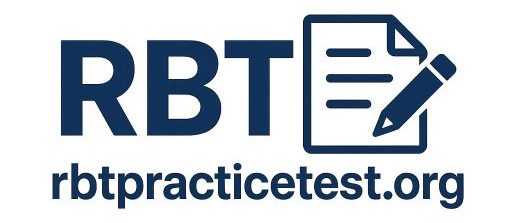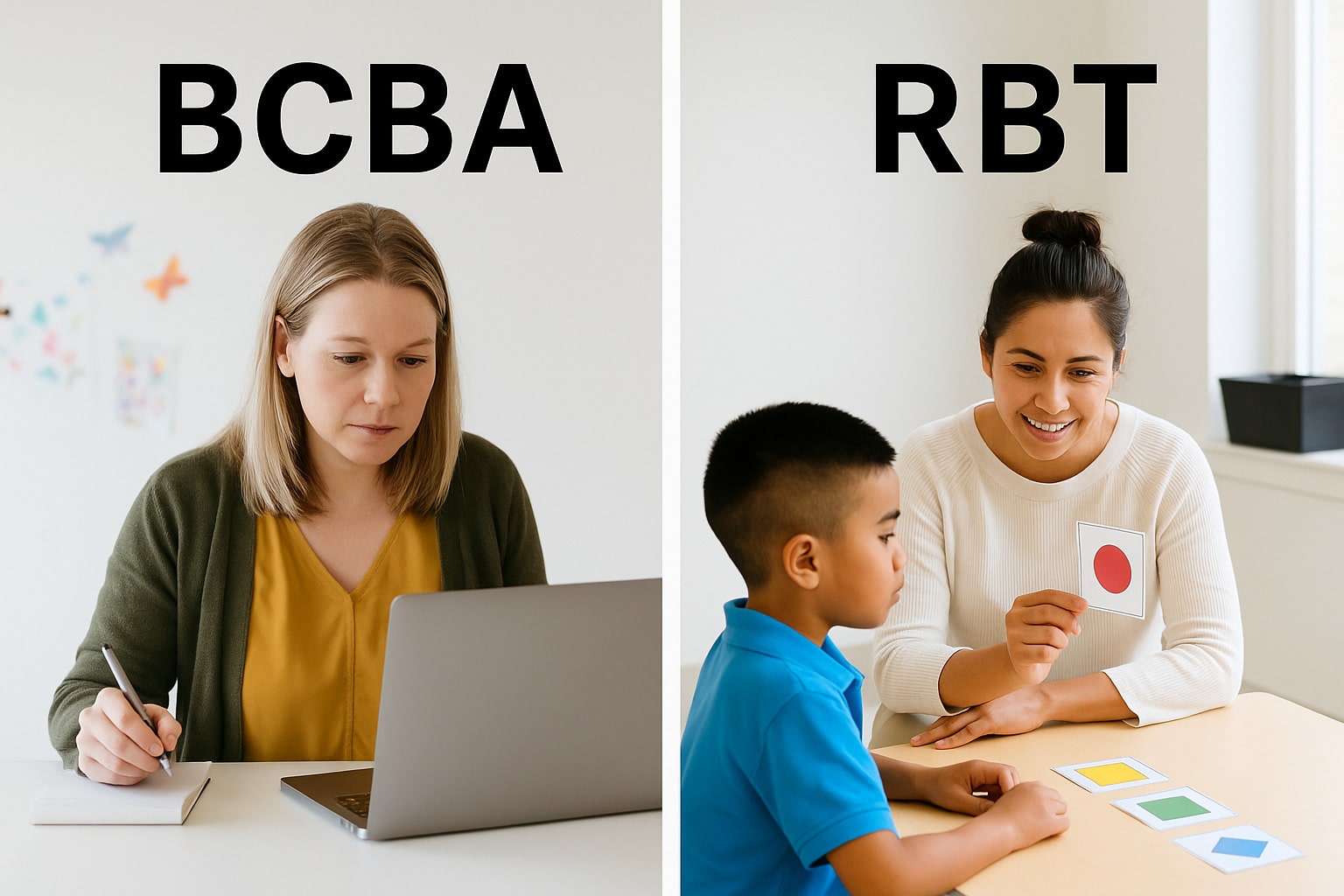When exploring a career in Applied Behavior Analysis (ABA), you’ll encounter two key roles: the Registered Behavior Technician (RBT) and the Board Certified Behavior Analyst (BCBA). Both contribute to behavior therapy, but they differ in qualifications, responsibilities, and clinical authority. RBTs provide direct support under supervision, while BCBAs design treatment plans, conduct assessments, and oversee therapy programs.
This guide below outlines the main differences between RBTs and BCBAs in terms of education, certification, job duties, salary, and career outlook. Whether you’re entering the field or considering advancement, understanding these roles will help you choose the path that best fits your goals.
What is an RBT?
RBTs are responsible for carrying out behavior intervention plans, collecting data, and supporting clients with developmental or behavioral challenges.
While RBTs are certified professionals, they do not design treatment plans. Instead, they follow procedures created by a supervising BCBA. This entry-level role offers hands-on experience and serves as a strong foundation for those who may later pursue BCBA certification.
What is a BCBA?
A BCBA, or Board Certified Behavior Analyst, is a highly trained professional who develops and oversees behavior therapy programs. BCBAs are responsible for assessing client needs, designing individualized treatment plans, and ensuring that interventions are based on applied behavior analysis principles.
To become a BCBA, individuals must earn a graduate degree in behavior analysis, education, psychology, or a related field. They are qualified to supervise RBTs and often work in schools, clinics, or healthcare settings, helping clients build essential life and academic skills through structured and effective behavioral strategies.
Key differences between RBTs and BCBAs
Now you know what each role involves, let’s compare side by side. RBTs and BCBAs both play vital roles in delivering Applied Behavior Analysis (ABA) therapy, but they differ significantly in scope of practice, education, certification, skills, and salary. The core distinction lies in the level of responsibility: BCBAs design and supervise treatment plans, while RBTs implement those plans under close supervision.
Job responsibilities
RBTs focus on direct service delivery. They work one-on-one with clients, implementing behavioral intervention plans created by a BCBA. Their tasks include collecting data, assisting with assessments, reducing problem behaviors, and documenting session progress. However, they are not authorized to conduct assessments or design treatment strategies.
BCBAs carry out a broader range of duties. They are responsible for functional behavior assessments, creating individualized ABA programs, training RBTs, and monitoring treatment effectiveness. BCBAs also collaborate with families, educators, and healthcare providers to align therapeutic goals across settings. They may oversee multiple cases and provide supervision to a team of behavior technicians.
Education and training requirements
To become an RBT, candidates must:
- Be at least 18 years old
- Hold a high school diploma or equivalent
- Complete a 40-hour training course
- Pass a background check and the RBT Competency Assessment
- Pass an RBT exam to get the RBT certification
In contrast, being BCBAs must:
- Earn a graduate degree (typically a master’s) in behavior analysis, psychology, education, or a related field
- Complete 315 hours of ABA coursework from an ABAI-verified program
- Accumulate 1,500–2,000 hours of supervised fieldwork
- Pass the BCBA certification exam
Certification and licensure
RBT certification is managed by the BACB. Certification is valid for one year and must be renewed annually through ongoing supervision, ethical compliance, and a renewal assessment. RBTs are not required to hold a state license in most areas.
If your certification expires, you must renew again. To pass the RBT certification exam, you have to prepare well by taking RBT practice exams frequently to understand the format and reinforce what you’ve learned.
BCBAs are also certified by the BACB, but their certification must be renewed every two years. Renewal requires continuing education and adherence to BACB ethics standards. Depending on the state, BCBAs may also need to obtain a state license to practice.
Required skills
Both RBTs and BCBAs must demonstrate empathy, patience, and professionalism. They need to adapt to client needs, maintain ethical standards, and communicate clearly with clients and families.
BCBAs, however, require more advanced skills in data analysis, assessment interpretation, and program design. They must also exhibit leadership abilities to manage teams and guide treatment implementation. Strong organizational and communication skills are essential for coordinating with stakeholders and supervising staff.
Salary and job outlook
In USA, experienced RBTs earn an average RBT salary of $54,000 per year, or about $25.96 per hour. Entry-level positions may start lower, while experienced RBTs or those working in high-demand areas may earn more.
BCBAs earn an average salary of $75,784 per year, with ranges typically falling between $68,000 to $85,000 depending on experience and location.
Job growth in ABA is strong. From 2010 to 2023, demand for BCBAs grew by over 5,800%, according to the BACB. The need for RBTs is also rising, with employment for related positions projected to grow 9% between 2021 and 2031, driven by increased demand for autism services and behavioral interventions.
Key takeaways
| Aspect | RBT | BCBA |
| Role | Implements ABA therapy under supervision | Designs and supervises ABA programs |
| Education | High school diploma + 40-hour training | Master’s degree + ABA coursework + supervised fieldwork |
| Certification | RBT competency assessment + RBT exam | BCBA Exam + 1,500–2,000 hours of supervised experience |
| Supervision | Must be supervised by a BCBA | Can practice independently and supervise RBTs |
| Average Salary | ~$54,000/year | ~$75,784/year |
| Job Outlook | High demand with steady growth | Rapid growth with demand increased over 5,800% from 2010 to 2023 |
Which role should you pursue?
You should pursue the RBT role if you want to start working in ABA quickly with minimal training, especially if you’re still exploring what is an RBT as a career path. As an RBT, you’ll gain hands-on experience by implementing behavior strategies directly with individuals. This practical, client-facing work is ideal for those who enjoy real-time interaction and skill development.
If your long-term goal is to take on more responsibility and lead therapeutic programs, the BCBA role offers a more advanced and strategic path. BCBAs play a leadership role in both clinical and educational settings, making data-driven decisions that impact entire treatment teams. For those seeking higher earning potential, greater autonomy, and broader career opportunities, pursuing the BCBA credential is a rewarding next step.
Whether you choose to become an RBT or a BCBA depends on your current qualifications, career goals, and the level of impact you wish to have within the field of behavior analysis. Both roles are esse

